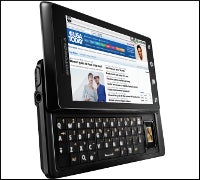 The Verizon Droid by Motorola. Click to enlarge. Source: Motorola |
Google and Verizon officially kicked off their love-fest with news that the Motorola Droid arrives on Verizon Nov. 6 with some exclusive features backed by the Internet giant.
In addition to being the first Android-powered handset for Verizon, Droid marks several firsts for the industry: At launch, it’s expected to be the only device shipping with version 2.0 of the open source mobile platform backed by Google (NASDAQ: GOOG).
It’s the only smartphone equipped with Google Maps Navigation and is the lead device to be born out of the newly minted partnership between Google and Verizon (NYSE: VZ).
The Droid, which comes in at the industry standard price point of $199 after rebates, sports a slide-out keyboard, a 5-megapixel camera, an accelerometer, Wi-Fi, Bluetooth and a Webkit-based, HTML 5-compatible browser juiced up by a 550MHz processor.
Weighing in at 6 ounces, Droid is 4.6-inches tall, 2.4 inches wide and half an inch thick. Its 3.7-inch touchscreen offers a 480×854 resolution. The device also has a 5.5mm headphone jack, micro-USB port and comes with a 16GB micro-SD card.
Google plugged its work with Verizon when highlighting details of its free, turn-by-turn mobile navigation app Google Maps Navigation.
“The first phone to have Google Maps Navigation and Android 2.0 is the Droid from Verizon,” the company said.
Motorola and Verizon embrace Android
Motorola, which so far has been far quieter about its role in Droid compared to Google and Verizon, described the phone today for the first time only as “Droid by Motorola, a smartphone powered by Android 2.0 developed in partnership with Google and Verizon Wireless.”
Much like Palm is pinning hopes for a revival on its own mobile platform webOS, Motorola is trying to resuscitate slumping performance by issuing a slew of Android-powered handsets. In September, it unveiled its first Android smartphone, the Motorola Cliq. Launched in partnership with the No. 4 U.S. carrier T-Mobile, the Cliq boast special software that synchronizes contacts, posts, messages and photos into a single stream.
Motorola’s recent embrace of Android comes as the latest victory for the upstart, open source mobile OS, which has won over a slew of phone makers and carriers seeking an answer to the Apple iPhone that they can customize to their own needs.
It’s also won fans among mobile developers seeking an alternative to the crowded iPhone app landscape, with recent data suggesting that Android may be set to become a permanent fixture among mobile OS, even eating into other, larger players’ market share.
Verizon, of course, isn’t placing all its hopes on Android. The nation’s largest wireless network has also nurtured a longtime relationship with Research In Motion (NASDAQ: RIMM) and is the preeminent carrier for many of its flagship BlackBerrys. Today, it also formally launched RIM’s BlackBerry Storm2, designed to take on the iPhone in the consumer market.
For Verizon, the Motorola Droid represents an opportunity to diversify its portfolio with another offering that could go head-to-head with the iPhone — for which rival AT&T still holds exclusive rights to sell in the U.S. — and to generate some buzz among consumers who may not want to buy BlackBerrys.
“Verizon has watched as other ‘big name’ smartphones have appeared, and never really had anything to offer in response,” Allen Nogee, a wireless analyst at In-Stat, told InternetNews.com. “Verizon needed to correct this, and it has with the Droid.”
“While the features and design of this Android phone aren’t radically different than Android HTC phones T-Mobile has had before it, this may be more than enough for Verizon fans, or those with poor AT&T coverage who can’t get an iPhone,” he said.
Though some industry watchers believe Verizon may have hurt its chances of ever carrying the iPhone after running ads for the Droid that poked fun at the shortcomings of the iPhone and AT&T, Verizon CEO Ivan Seidenberg said he’s still game to work with Apple.
“We would be interested if they wanted us as a partner,” he told analysts during the company’s most recent earnings call.
Even without the iPhone, Verizon hasn’t been hurting. The company still ranks No. 1 on the wireless front, with 88.9 million subscribers — even after No. 2 AT&T had another stellar quarter due to record-breaking iPhone sales that helped it grow to 81.6 million subscribers.
No. 3 U.S. carrier Sprint reports tomorrow, and is counting on the Palm (NASDAQ: PALM) Pre and Pixi, along with the Android-powered HTC Hero and Samsung Moment, to up the ante.


